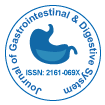The Etiology and Treatment of Gastroesophageal Reflux Disease
Received: 02-Jan-2023 / Manuscript No. JGDS-23-90378 / Editor assigned: 04-Jan-2023 / PreQC No. JGDS-23-90378 (PQ) / Reviewed: 18-Jan-2023 / QC No. JGDS-23-90378 / Revised: 23-Jan-2023 / Manuscript No. JGDS-23-90378 (R) / Published Date: 30-Jan-2023
Description
Gastroesophageal reflux infection (GERD) happens when stomach corrosive over and over streams once again into the cylinder associating your mouth and stomach (throat). This discharge (heartburn) can disturb the covering of your throat. Many individuals experience indigestion now and again. In any case, when heartburn happens more than once, it can cause GERD. A great many people can deal with the distress of GERD with way of life changes and drugs. Furthermore, however it's un-precedented, some might require a medical procedure to ease side effects.
Currently, there is no known reason to make sense of the advancement of GERD. Throughout the long term, a few gamble factors have been recognized and embroiled in the pathogenesis of GERD. Engine irregularities, for example, esophageal dysmotility causing disabled esophageal corrosive freedom, weakness in the tone of the lower esophageal sphincter (LES), transient LES unwinding, and deferred gastric purging are remembered for the causation of GERD. When you eat, food passes from the throat to the stomach through the throat. A ring of muscle filaments in the lower throat keeps gobbled food from moving back up. These muscle strands are known as the lower esophageal sphincter (LES). While this ring of muscle doesn't close as far as possible, stomach items can spill once more into the throat. This is called reflux or gastroesophageal reflux. Reflux might cause side effects. Cruel stomach acids can likewise harm the covering of the throat.
The primary side effects are tenacious indigestion and corrosive spewing forth. Certain individuals have GERD without acid reflux. All things being equal, they experience torment in the chest, roughness in the first part of the day or inconvenience gulping. You might feel like you have food stuck in your throat, or like you are gagging or your throat is tight. GERD can likewise cause a dry hack and terrible breath.
Hiatal hernia is often connected with GERD and can exist freely without bringing on any side effects. In any case, the presence of hiatal hernia assumes an imperative part in the pathogenesis of GERD as it thwarts the LES capability. Nonetheless, patients with enormous hiatal hernias were noted to have more limited and more fragile LES bringing about expanded reflux episodes. It was likewise brought up that the level of esophagitis was more terrible in patients with huge hiatal hernias.
Hiatal hernia is often connected with GERD and can exist freely without bringing on any side effects. In any case, the presence of hiatal hernia assumes an imperative part in the pathogenesis of GERD as it thwarts the LES capability. Nonetheless, patients with enormous hiatal hernias were noted to have more limited and more fragile LES bringing about expanded reflux episodes. It was likewise brought up that the level of esophagitis was more terrible in patients with huge hiatal hernias.
The objectives of overseeing GERD are to address the goal of side effects and forestall entanglements like esophagitis, BE, and esophageal adenocarcinoma. Therapy choices incorporate way of life adjustments, clinical administration with acid neutralizers and antisecretory specialists, careful treatments, and endoluminal treatments. Patients who present with medicinally stubborn GERD, rebelliousness, or experience incidental effects with clinical treatment, fundamental enormous hiatal hernia, or people who want to end long haul clinical treatment can be considered for careful administration.
Instances of patients with restoratively hard-headed GERD ought to be examined in a multidisciplinary approach with the specialists, drug specialists, and endoscopy medical caretakers. Entanglements of GERD ought to be quickly perceived, assessed, and treated to forestall long haul dismalness. This inter-professional approach helps in the administration of GERD, bringing about better patients results and expanded personal satisfaction.
Acknowledgement
None
Conflict of Interest
The author has no potential conflicts of interest.
Citation: Haniya R (2023) The Etiology and Treatment of Gastroesophageal Reflux Disease. J Gastrointest Dig Syst 13:728.
Copyright: © 2023 Haniya R. This is an open-access article distributed under the terms of the Creative Commons Attribution License, which permits unrestricted use, distribution, and reproduction in any medium, provided the original author and source are credited.
Select your language of interest to view the total content in your interested language
Share This Article
Recommended Journals
Open Access Journals
Article Usage
- Total views: 1490
- [From(publication date): 0-2023 - Sep 30, 2025]
- Breakdown by view type
- HTML page views: 1160
- PDF downloads: 330
